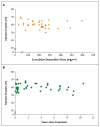Dose-adjusted EPOCH-rituximab therapy in primary mediastinal B-cell lymphoma
- PMID: 23574119
- PMCID: PMC4568999
- DOI: 10.1056/NEJMoa1214561
Dose-adjusted EPOCH-rituximab therapy in primary mediastinal B-cell lymphoma
Abstract
Background: Primary mediastinal B-cell lymphoma is a distinct subtype of diffuse large-B-cell lymphoma that is closely related to nodular sclerosing Hodgkin's lymphoma. Patients are usually young and present with large mediastinal masses. There is no standard treatment, but the inadequacy of immunochemotherapy alone has resulted in routine consolidation with mediastinal radiotherapy, which has potentially serious late effects. We aimed to develop a strategy that improves the rate of cure and obviates the need for radiotherapy.
Methods: We conducted a single-group, phase 2, prospective study of infusional dose-adjusted etoposide, doxorubicin, and cyclophosphamide with vincristine, prednisone, and rituximab (DA-EPOCH-R) and filgrastim without radiotherapy in 51 patients with untreated primary mediastinal B-cell lymphoma. We used results from a retrospective study of DA-EPOCH-R from another center to independently verify the outcomes.
Results: The patients had a median age of 30 years (range, 19 to 52) and a median tumor diameter of 11 cm; 59% were women. During a median of 5 years of follow-up, the event-free survival rate was 93%, and the overall survival rate was 97%. Among the 16 patients who were involved in the retrospective analysis at another center, over a median of 3 years of follow-up, the event-free survival rate was 100%, and no patients received radiotherapy. No late morbidity or cardiac toxic effects were found in any patients. After follow-up ranging from 10 months to 14 years, all but 2 of the 51 patients (4%) who received DA-EPOCH-R alone were in complete remission. The 2 remaining patients received radiotherapy and were disease-free at follow-up.
Conclusions: Therapy with DA-EPOCH-R obviated the need for radiotherapy in patients with primary mediastinal B-cell lymphoma. (Funded by the National Cancer Institute; ClinicalTrials.gov number, NCT00001337.).
Figures


Comment in
-
Haematological cancer: new standard of care?Nat Rev Clin Oncol. 2013 Jun;10(6):305. doi: 10.1038/nrclinonc.2013.69. Epub 2013 Apr 23. Nat Rev Clin Oncol. 2013. PMID: 23609317 No abstract available.
-
Therapy in primary mediastinal B-cell lymphoma.N Engl J Med. 2013 Jul 18;369(3):283-4. doi: 10.1056/NEJMc1305983. N Engl J Med. 2013. PMID: 23863059 No abstract available.
-
Therapy in primary mediastinal B-cell lymphoma.N Engl J Med. 2013 Jul 18;369(3):282. doi: 10.1056/NEJMc1305983. N Engl J Med. 2013. PMID: 23863060 No abstract available.
-
Therapy in primary mediastinal B-cell lymphoma.N Engl J Med. 2013 Jul 18;369(3):282-3. doi: 10.1056/NEJMc1305983. N Engl J Med. 2013. PMID: 23863061 No abstract available.
References
-
- Savage KJ, Monti S, Kutok JL, et al. The molecular signature of mediastinal large B-cell lymphoma differs from that of other diffuse large B-cell lymphomas and shares features with classical Hodgkin’s lymphoma. Blood. 2003;102:3871–9. - PubMed
-
- Swerdlow SH, Campo E, Harris NL, Campo E, et al. WHO classification of tumours of haematopoietic and lymphoid tissues. 4. Lyon, France: International Agency for Research on Cancer; 2008.
-
- van Besien K, Kelta M, Bahaguna P. Primary mediastinal B-cell lymphoma: a review of pathology and management. J Clin Oncol. 2001;19:1855–64. - PubMed
-
- Bishop PC, Wilson WH, Pearson D, Janik J, Jaffe ES, Elwood PC. CNS involvement in primary mediastinal large B-cell lymphoma. J Clin Oncol. 1999;17:2479–85. - PubMed
Publication types
MeSH terms
Substances
Supplementary concepts
Associated data
Grants and funding
LinkOut - more resources
Full Text Sources
Other Literature Sources
Medical
